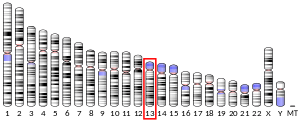TSC22D1
TSC22 domain family protein 1 is a protein that in humans is encoded by the TSC22D1 gene.[5][6]
TSC22 encodes a transcription factor and belongs to the large family of early response genes.[7]
TSC22D1 forms homodimers via its conserved leucine zipper domain and heterodimerizes with TSC22D4. TSC22D1 has transcriptional repressor activity.[8]
References
- 1 2 3 GRCh38: Ensembl release 89: ENSG00000102804 - Ensembl, May 2017
- 1 2 3 GRCm38: Ensembl release 89: ENSMUSG00000022010 - Ensembl, May 2017
- ↑ "Human PubMed Reference:".
- ↑ "Mouse PubMed Reference:".
- ↑ Jay P, Ji JW, Marsollier C, Taviaux S, Berge-Lefranc JL, Berta P (Jul 1996). "Cloning of the human homologue of the TGF beta-stimulated clone 22 gene". Biochem Biophys Res Commun. 222 (3): 821–6. doi:10.1006/bbrc.1996.0825. PMID 8651929.
- ↑ Ohta S, Shimekake Y, Nagata K (Mar 1997). "Molecular cloning and characterization of a transcription factor for the C-type natriuretic peptide gene promoter". Eur J Biochem. 242 (3): 460–6. doi:10.1111/j.1432-1033.1996.460rr.x. PMID 9022669.
- ↑ "Entrez Gene: TSC22D1 TSC22 domain family, member 1".
- ↑ Kester HA, Blanchetot C, den Hertog J, van der Saag PT, van der Burg B (September 1999). "Transforming growth factor-beta-stimulated clone-22 is a member of a family of leucine zipper proteins that can homo- and heterodimerize and has transcriptional repressor activity". J. Biol. Chem. 274 (39): 27439–47. doi:10.1074/jbc.274.39.27439. PMID 10488076.
Further reading
- Shibanuma M, Kuroki T, Nose K (1992). "Isolation of a gene encoding a putative leucine zipper structure that is induced by transforming growth factor beta 1 and other growth factors". J. Biol. Chem. 267 (15): 10219–24. PMID 1587811.
- Dmitrenko VV, Garifulin OM, Shostak EA, et al. (1997). "[The characteristics of different types of mRNA expressed in the human brain]". Tsitol. Genet. 30 (5): 41–7. PMID 9026990.
- Kester HA, Blanchetot C, den Hertog J, et al. (1999). "Transforming growth factor-beta-stimulated clone-22 is a member of a family of leucine zipper proteins that can homo- and heterodimerize and has transcriptional repressor activity". J. Biol. Chem. 274 (39): 27439–47. doi:10.1074/jbc.274.39.27439. PMID 10488076.
- Hino S, Kawamata H, Uchida D, et al. (2001). "Nuclear translocation of TSC-22 (TGF-beta-stimulated clone-22) concomitant with apoptosis: TSC-22 as a putative transcriptional regulator". Biochem. Biophys. Res. Commun. 278 (3): 659–64. doi:10.1006/bbrc.2000.3840. PMID 11095965.
- Hino S, Kawamata H, Omotehara F, et al. (2002). "Leucine zipper structure of TSC-22 (TGF-beta stimulated clone-22) markedly inhibits the anchorage-independent growth of salivary gland cancer cells". Oncol. Rep. 9 (2): 371–4. doi:10.3892/or.9.2.371. PMID 11836610.
- Hino S, Kawamata H, Omotehara F, et al. (2002). "Cytoplasmic TSC-22 (transforming growth factor-beta-stimulated clone-22) markedly enhances the radiation sensitivity of salivary gland cancer cells". Biochem. Biophys. Res. Commun. 292 (4): 957–63. doi:10.1006/bbrc.2002.6776. PMID 11944908.
- Ohara O, Nagase T, Mitsui G, et al. (2003). "Characterization of size-fractionated cDNA libraries generated by the in vitro recombination-assisted method". DNA Res. 9 (2): 47–57. doi:10.1093/dnares/9.2.47. PMID 12056414.
- Gupta RA, Sarraf P, Brockman JA, et al. (2003). "Peroxisome proliferator-activated receptor gamma and transforming growth factor-beta pathways inhibit intestinal epithelial cell growth by regulating levels of TSC-22". J. Biol. Chem. 278 (9): 7431–8. doi:10.1074/jbc.M208076200. PMID 12468551.
- Strausberg RL, Feingold EA, Grouse LH, et al. (2003). "Generation and initial analysis of more than 15,000 full-length human and mouse cDNA sequences". Proc. Natl. Acad. Sci. U.S.A. 99 (26): 16899–903. doi:10.1073/pnas.242603899. PMC 139241. PMID 12477932.
- Sugawara F, Yamada Y, Watanabe R, et al. (2004). "The role of the TSC-22 (-396) A/G variant in the development of diabetic nephropathy". Diabetes Res. Clin. Pract. 60 (3): 191–7. doi:10.1016/S0168-8227(03)00038-X. PMID 12757981.
- Uchida D, Omotehara F, Nakashiro K, et al. (2003). "Posttranscriptional regulation of TSC-22 (TGF-beta-stimulated clone-22) gene by TGF-beta 1". Biochem. Biophys. Res. Commun. 305 (4): 846–54. doi:10.1016/S0006-291X(03)00854-4. PMID 12767908.
- Gerhard DS, Wagner L, Feingold EA, et al. (2004). "The status, quality, and expansion of the NIH full-length cDNA project: the Mammalian Gene Collection (MGC)". Genome Res. 14 (10B): 2121–7. doi:10.1101/gr.2596504. PMC 528928. PMID 15489334.
- Choi SJ, Moon JH, Ahn YW, et al. (2005). "Tsc-22 enhances TGF-beta signaling by associating with Smad4 and induces erythroid cell differentiation". Mol. Cell. Biochem. 271 (1–2): 23–8. doi:10.1007/s11010-005-3456-7. PMID 15881652.
- Rentsch CA, Cecchini MG, Schwaninger R, et al. (2006). "Differential expression of TGFbeta-stimulated clone 22 in normal prostate and prostate cancer". Int. J. Cancer. 118 (4): 899–906. doi:10.1002/ijc.21449. PMID 16106424.
- Stelzl U, Worm U, Lalowski M, et al. (2005). "A human protein-protein interaction network: a resource for annotating the proteome". Cell. 122 (6): 957–68. doi:10.1016/j.cell.2005.08.029. PMID 16169070.
- Ewing RM, Chu P, Elisma F, et al. (2007). "Large-scale mapping of human protein-protein interactions by mass spectrometry". Mol. Syst. Biol. 3 (1): 89. doi:10.1038/msb4100134. PMC 1847948. PMID 17353931.
- Lu Y, Kitaura J, Oki T, et al. (2007). "Identification of TSC-22 as a potential tumor suppressor that is upregulated by Flt3-D835V but not Flt3-ITD". Leukemia. 21 (11): 2246–57. doi:10.1038/sj.leu.2404883. PMID 17690703.
External links
- TSC22D1 protein, human at the US National Library of Medicine Medical Subject Headings (MeSH)
This article incorporates text from the United States National Library of Medicine, which is in the public domain.
This article is issued from
Wikipedia.
The text is licensed under Creative Commons - Attribution - Sharealike.
Additional terms may apply for the media files.




